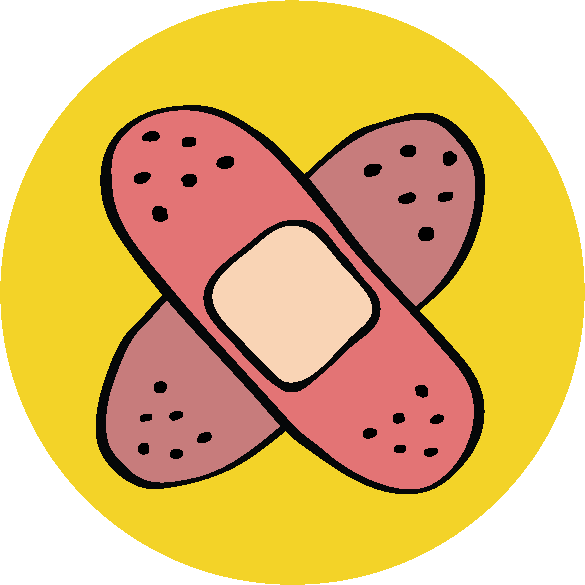Pet Care Info
• • • Information Handouts • • •

Handouts by Dr. Sophia Yin
- Step-by-step checklist for properly socializing your puppy : [Download PDF]
- Step-by-step detailed instructions for crate training your dog or cat: [Download PDF]

Skin Allergies in Pets
by Dr. Sarah Wineke, Lake Harriet Veterinary
• • • Grief Resources • • •
Loss and Euthanasia Resources and Hotlines |
Reading List for Adults |
Reading List for Children |
|---|---|---|
|
|
• • • How-To Videos • • •
• • • Articles • • •
Guide to Brushing Your Pet’s Teeth
 Our animal companions are an important part of our lives for many years and dental care is crucial to maintaining their good health. Dental disease is the most common problem seen in our pet population today. More than 85% of all dogs and cats over 3 years of age presented to veterinarians are affected by dental problems. Periodontal disease is the cause of your pet’s bad breath and painful mouth, and may cause infections of the kidneys, liver, and heart.
Our animal companions are an important part of our lives for many years and dental care is crucial to maintaining their good health. Dental disease is the most common problem seen in our pet population today. More than 85% of all dogs and cats over 3 years of age presented to veterinarians are affected by dental problems. Periodontal disease is the cause of your pet’s bad breath and painful mouth, and may cause infections of the kidneys, liver, and heart.
We recommend daily dental care at home for your companion animals just like the rest of the family. It is best to begin home care at an early age (8-12 weeks), but visible tartar should be removed during a thorough dental cleaning. This makes your home care easier and more effective.
Supplies needed:
- toothbrush
- pet toothpaste (never human toothpaste)
Week 1: slowly acquainting your pet with mouth care:
Using your hand, gently open your animal companion’s mouth and run your finger around the lips. Rub the outside of the mouth and massage the cheeks. This gets her used to having her mouth touched. Begin for thirty seconds on day one and progress to a couple of minutes by the end of the week. Reward your pet with a small treat at the end of each session.
Week 2: introducing toothbrush or washcloth (without toothpaste):
This week, use either a wet washcloth wrapped around your index finger or wet toothbrush on
the teeth. Lift the lips and massage the outer surfaces of the upper and lower teeth using a back
and forth motion. Do this for thirty seconds on day one and progress to three minutes by the end of the week.
Week 3: add toothpaste and extend brushing time:
This week, use your dental cleaning instrument and now add ¾ inch of toothpaste to brush the outer surfaces of the upper and lower teeth using a back and forth motion. If possible, try to brush the inner surfaces of the teeth. The inner surfaces are harder to get at but the tartar builds up more quickly on the outer surfaces. Always give a small treat at the end of each session…make it rewarding.
If you find brushing impossible there are other products you can use to maintain good oral health, but eventually we will recommend a professional dental cleaning.
- CET chews, Greenies, and other dental treats are available for dogs and cats. These are enzymatically treated to help remove bacteria before it builds up and turns to tartar that cannot be removed with simple brushing.
- Especially formulated dental diets are available for dogs and cats. These foods can be used as a regular complete diet or as a treat and we can write a prescription for you to pick these up at another clinic. If we think this is necessary for your pet we will discuss it with you.
- Some dogs may benefit from chewing on bones, however, you should realize this will increase their risk of tooth fractures and excessive wearing of the teeth.
Choosing a Pet Food for Your Healthy Pet
The dizzying array of pet foods available today can be overwhelming when trying to decide what food is best for your pet. We’ve compiled a list of factors to consider when choosing what to feed. Please keep in mind that these factors may change when there are health concerns, such as skin allergies, chronic GI disease, or kidney disease.
- Does this diet fit with your own personal nutrition philosophies?
Everyone has different considerations and priorities when deciding what to feed themselves and their families. Some of these factors include where and how the ingredients are sourced (local, organic, fair trade, etc.), inclusion or exclusion of specific nutrients, availability, and cost. Fortunately, the wide variety of options at the store means there are commercial diets to fit nearly any feeding philosophy. There is one critical point that we insist on, however: you should always feed a species-appropriate diet for your pet. This means that even if you are vegan, we cannot condone the same diet for an obligate carnivore, such as a cat.
- Is the diet appropriate for the species and life stage of your pet?
Pet foods are either available for specific life stages (i.e., puppy, adult, lactating mothers) or for all life stages. Check to be sure the label indicates the diet is appropriate for the age and species of your pet.
- Does your pet have well-formed stools and a healthy coat?
Chronic soft stools or a dry, flaky skin and coat are potential indicators that a pet isn’t absorbing or utilizing nutrients well from their diet. Each animal is an individual: one pet may thrive on a grain-free food, while another may struggle with chronic diarrhea on a grain-free diet. If your pet’s stools and coat are not healthy-looking, consider trying a different type of food.
- Does your pet enjoy eating its food?
Mealtime should be enjoyable for everyone! Your pet should find his diet palatable, without the need for top-dressing with extra goodies.
- Is your pet able to maintain a healthy body weight on the food?
Dry pet foods can range widely, from 250 calories to over 500 calories per cup. If your pet tends to be overweight and you find it difficult to feed him smaller meals, it may be necessary to find a food that is lower in calories to help him maintain a healthy weight.
Good nutrition can make a world of difference for your pet’s health—just like it can for us, humans! If you’d like more help with choosing the right foods for your pet, please make an appointment with your veterinarian to discuss the subject.
•••
Hypo-Allergenic Diets
Skin Allergies in Pets
Tips for Less Stressful Vet Visits ~ Cat Edition
Vaccination Protocol
Print this document (for both dogs and cats)

A widespread canine and feline vaccination programs have played a crucial role in the prevention of infectious diseases in veterinary medicine. As pets have assumed a different role in the modern family and risk factors have changed the vaccination schedule has changed accordingly. We seek a compromise between maximizing immunity to diseases and minimizing possible short and long-term side effects from vaccines. The risks versus benefits of using certain vaccines or of administering multiple vaccines at the same visit need to be strongly reconsidered. It is now known that some vaccines may be unnecessary and that their use may increase the risk of adverse reactions. Cats in particular can have an uncommon and poorly understood reaction to certain components in vaccines which in the worst cases can result in the formation of a cancerous tumor.In addition, there are studies that now show the duration of immunity from many vaccines is much longer than one year. When we consider if and when a dog or cat needs to be vaccinated its health, age, risk of exposure, lifestyle, and past medical and vaccination history are important variables to assess.
The following vaccine protocol is our recommendation to meet the requirements of the City of Minneapolis but it may be modified. It includes the “core” vaccines and should not be interpreted to mean that other protocols recommended are not valid. It is a matter of professional judgment and choice.
Puppies:
- 8 weeks of age: Distemper, Parvo, Parainfluenza, Adeno (DAPP)
- 12 wks: DAPP
- 16 wks: DAPP (if needed)
- 16 wks or older: Rabies
- 1 year of age: DAPP (3 yr duration)
- 1 year of age: Rabies (3 yr duration)
Kittens:
- 8 weeks of age: Panleukopenia, Rhinotracheitis, and Calicivirus (RCP)
- 12 wks (if needed): FVRCP and (if needed) FeLV
- 16 wks (if needed): FVRCP and (if needed) FeLV
- 16 wks or older: Rabies
- 1–1.5 years of age: FVRCP (3 yr duration)
- 1–1.5 years of age: Rabies (1 yr duration)
Adult Dogs:
As long as we can establish a previous rabies vaccine has been given, subsequent rabies vaccines are given every 3 years as required by law. Similarly we recommend the DAPP be given every 3 years. In some circumstances it may be wise to consider a vaccine titer that can serve as a measure of your pet’s immunity to these diseases. This is a conversation best had with your veterinarian.
We recommend vaccination for Lyme disease, leptospirosis, and kennel cough. The first 2 diseases are life-threatening and all 3 are common, and we are happy to discuss the merits of each during your appointment. Always tell us about your dog’s environment, travel, and medical history so that we can make an informed decision about vaccines.
Adult Cats:
We strongly recommend the Imrab Purevax (1-year) rabies vaccine because it is free of the additives they are thought to contribute to side effects in cats. We no longer recommend the previously used 3-year rabies vaccine for cats.
RCP should be given only once every 3 years for most adult cats where there is an established vaccine history. Circumstances may arise in which we recommend it be discontinued altogether.
Feline Leukemia Virus (FeLV): All kittens and cats with an unknown FeLV status should be tested for this disease. Feline leukemia is a risk to cats that go outdoors and/or are exposed to infected cats. Kittens with risk of exposure should be given a FeLV vaccine at 12 and 16 weeks, and then every 1-3 years depending on risk and age.
•••
Spay & Neuter Information for Dogs
The ideal timing for spaying or neutering your dog depends on a wide variety of factors and is no longer an easy “one size fits all” answer. We ask that you discuss with your veterinarian and consider these important factors in the decision. Recommended further reading: https://www.petmd.com/dog/care/evr_determining_best_age_to_spay_or_neuter
- Your pet’s lifestyle and activity goals:
- An intact dog may not be allowed at daycare
- A female dog in heat (estrus) is at risk of pregnancy. Daycare, dog parks, andother social activities may be risky
- Highly active larger, giant dogs and participation in sporting activities (e.g., agility)may increase risk of joint and ligament disease if sterilized before 1 year
- Ability to manage an intact (not sterilized) pet behaviorally:
- Avoidance of high risk environments/interactions during female in heat
- Bleeding and “diaper” use for female in heat
- Escape and roaming behavior with intact male; urine marking and mounting
- The health risks of remaining intact (not sterilized):
- Increased breast (mammary) cancer in females
- Risk of uterine infection (pyometra) in females
- Increased testicular cancer, benign prostatic hypertrophy (BPH), and perianal growths in males
- The increased cost and potential increased surgical risk of later sterilization:
- Larger scrotum and potential increased scrotal bleeding/hematoma after neuter
- Larger ovarian and uterine blood vessels, increased fat, decreasedvisualization, and increased risk of bleeding with spay
- Emergency pyometra surgery is expensive
- The current understanding on increased health risks of sterilization:
- Some breeds have increased risk of certain cancers with sterilization which varies by age and sex. The breed chart below considers this current information. This was published in a study by UC Davis in July 2020: https://www.frontiersin.org/articles/10.3389/fvets.2020.00388/full
- Increased risk of urinary incontinence in female dogs
- Increased risk of obesity and diabetes
- Increased risk of joint disease in large dogs (especially cranial cruciate disease [ACL])
Local Dog Resources
What’s Feline Lower Urinary Tract Disease (FLUTD)?
What’s Degenerative Joint Disease/Osteoarthritis (DJD/OA)?
Poisonous Plant List (Source: ASPCA)
 Please click here for an extensive list by the ASPCA.
Please click here for an extensive list by the ASPCA.




 Print this document
Print this document Printable PDF
Printable PDF
 Printable PDF
Printable PDF